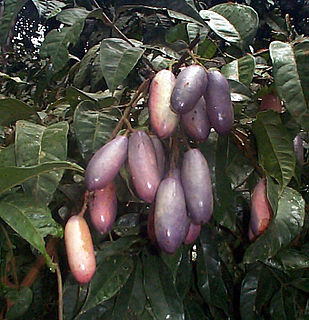
Hesperocyparis macrocarpa is a coniferous tree. It is commonly known as the Monterey cypress and is one of several species of cypress trees endemic to California. In New Zealand, where it is also widespread, it is simply known as "macrocarpa".

Dacryodes edulis is a fruit tree native to Africa, sometimes called safou (Cameroon), atanga, ube (Nigeria), African pear, bush pear, African plum, nsafu, bush butter tree, or butterfruit.
Canarium pseudopatentinervium is a plant in the incense tree family Burseraceae. The specific epithet pseudopatentinervium is from the Latin meaning "false patentinervium", referring to the species' resemblance to Canarium patentinervium.
Mastixia macrocarpa is a tree in the family Nyssaceae. The specific epithet macrocarpa is from the Greek meaning "large fruit".

Dacryodes is a genus of about 60 species of trees in the family Burseraceae. The generic name is from the Greek dakruon meaning "tear(drop)", referring to how resin droplets form on the bark surface.

Xylocarpus moluccensis is a tree in the family Meliaceae. It is named for the Moluccas archipelago.
Canarium apertum is a tree in the family Burseraceae. The specific epithet apertum is from the Latin meaning "open", referring to the basal openings between petals.
Canarium grandifolium is a tree in the family Burseraceae. The specific epithet grandifolium is from the Latin meaning "large leaf".
Canarium merrillii is a tree in the family Burseraceae. It is named for the American botanist Elmer Drew Merrill.
Dacryodes costata is a tree in the family Burseraceae. The specific epithet costata is from the Latin meaning "ribbed", likely referring to the prominent veins on the leaf underside.
Dacryodes elmeri is a tree in the family Burseraceae. It is named for the American botanist Adolph Elmer.
Dacryodes expansa is a tree in the family Burseraceae. The specific epithet expansa is from the Latin meaning "spread out", referring to the structure of the petals.
Dacryodes incurvata is a tree in the family Burseraceae. The specific epithet incurvata is from the Latin meaning "bending inward", referring to the leaflet margin.
Dacryodes laxa is a tree in the family Burseraceae. The specific epithet laxa is from the Latin meaning "loose", referring to the inflorescence.
Dacryodes longifolia is a tree in the family Burseraceae. The specific epithet longifolia is from the Latin meaning "long leaf".
Dacryodes nervosa is a tree in the family Burseraceae. The specific epithet nervosa is from the Latin meaning "with nerves", referring to the leaves.

Dacryodes rostrata is a tree in the family Burseraceae. The specific epithet rostrata is from the Latin meaning "beaked", referring to the narrow-tipped leaves.
Dacryodes rubiginosa is a tree in the family Burseraceae. The specific epithet rubiginosa is from the Latin meaning "rust-coloured", referring to the tomentum.
Dacryodes rugosa is a tree in the family Burseraceae. The specific epithet rugosa is from the Latin meaning "wrinkled", referring to the leaflets.
Dacryodes rugosa var. virgata is a tree in the family Burseraceae.



